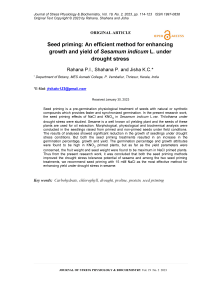Seed priming: an efficient method for enhancing growth and yield of Sesamum indicum L. under drought stress
Автор: Rahana P.I., Shahana P., Jisha K.C.
Журнал: Журнал стресс-физиологии и биохимии @jspb
Статья в выпуске: 2 т.19, 2023 года.
Бесплатный доступ
Seed priming is a pre-germination physiological treatment of seeds with natural or synthetic compounds which provides faster and synchronized germination. In the present research work, the seed priming effects of NaCl and KNO3 in Sesamum indicum L.var. Thilothama under drought stress were studied. Sesame is a well known oil yielding plant and the seeds of these plants are used for oil extraction. Morphological, physiological and biochemical analysis were conducted in the seedlings raised from primed and non-primed seeds under field conditions. The results of analyses showed significant reduction in the growth of seedlings under drought stress conditions. But both the seed priming treatments resulted in an increase in the germination percentage, growth and yield. The germination percentage and growth attributes were found to be high in KNO3 primed plants, but as far as the yield parameters were concerned, the fruit weight and seed weight were found to be maximum in NaCl primed plants. Thus from the present research work, it was concluded that both the seed priming methods improved the drought stress tolerance potential of sesame and among the two seed priming treatments, we recommend seed priming with 15 mM NaCl as the most effective method for enhancing yield under drought stress in sesame.
Carbohydrate, chlorophyll, drought, proline, protein, seed priming
Короткий адрес: https://sciup.org/143180101
IDR: 143180101
Текст научной статьи Seed priming: an efficient method for enhancing growth and yield of Sesamum indicum L. under drought stress
Plant growth is frequently come across with different environmental stresses in their growth period. Among the growth stages, germination and early vegetative growth are more prone to these stresses. Abiotic and biotic stresses severely affect the crop’s growth and development at every stage of growth cycle. Abiotic stresses adversely affect the growth and productivity and trigger a series of morphological, biochemical and molecular changes in plants (Wang et al ., 2001). During the course of evolution, plants have developed precise mechanisms to sense the subtle changes of growth conditions, and trigger signal transduction cascades, which in turn activate stress responsive genes and ultimately direct to changes at the physiological and biochemical levels (Gao et al ., 2007). Drought stress is one of the major abiotic stress for crop plants particularly in the tropics. According to Kim et al. (2012), drought is one of the major constraints for reduction of crop yield in the tropical world. Water availability is a major limiting factor for the germination and early establishment of arid and semi-arid plants (Zeng et al., 2010). Plant response to water deficient are depend on the amount of water loss, the rate of water loss, the duration of drought stress, the plant variety/species under consideration, developmental stages of the plant and other environmental variables, such as temperature, relative humidity, etc. (Soren et al ., 2010).
Several methods are regularly employing in the plant breeding research for imparting abiotic stress tolerance in different plants. Among these methods, seed priming is a promising one. It has proved to be an effective method to impart abiotic stress tolerance to plants. It is a pre-germination physiological treatment of seeds with natural or synthetic compounds which provides faster and synchronized germination. It is a controlled procedure followed by re-drying which will allow the seed to imbibe water, stimulate the internal biological process essential for germination but this process will not permit the seed to be truly germinates (Mustafa et al., 2017). Seed priming is an efficient method for improving the seed germination and reducing the maturation time in any plants under field conditions. However, the effectiveness of any seed prming methods relay on different conditions like type of priming agent employed, priming duration, concentration of priming agent, temperature, etc. Thus, in the present research work, effects of two different chemical priming (KNO3 priming and NaCl priming) on Sesamum indicum L. under drought stress in the field conditions were compared by analyzing the different growth attributes and stress indicators of seedlings and also the yield of plants raised from primed and non-primed seeds.
MATERIALS AND METHODS
Plant material
Sesame ( Sesamum indicum L.) is a member of Pedaliaceae family and is an important oil crop. Seeds of sesame variety Thilothama were procured from Kerala Agricultural University, Thrissur, Kerala, India.
Seed priming techniques
Identical and healthy seeds of sesame were washed with 0.1% HgCl2 and the process was followed by washing with detergent solution and distilled water respectively. The surface sterilized seeds were then kept in various concentrations of NaCl and KNO3 solutions in glass beakers. The seed priming concentrations of NaCl and KNO3 were identified based on standardization procedures. After seed priming treatments, the seeds were surface dried on absorbent paper and kept until original weight was re-gained.
Raising of seedlings under field conditions and application of drought stress in the field
The primed and non-primed seeds were sowed in grow bags separately. or each treatments, ten bags were used and one seed was sowed in each bag. All the polythene bags were filled uniformly with soil, cow dung, sand and bone meal in 1:1:1:1 ratio. The bags were watered twice a day regularly. After attaining a specific growth, ie two week old seedlings were collected from each bag and shoot length, root length, fresh weight and dry weight of seedlings were recorded. Estimation of photosynthetic pigments, Malondialdehyde (MDA), proline and total protein were done. The plants were then subjected to drought stress for two weeks. Drought was applied by withdrawing the water supply to plants.
The physiological and biochemical attributes of the plants under drought stress were also analyzed.
Growth parameters
The major growth parameters studied were shoot length, fresh weight, dry weight and moisture content. or shoot length measurements, graduated scale was used and expressed in centimeters. resh weight and dry weight measurements were carried out with the help of an electronic balance. or the measurements, the plants were brought from the field and the fresh weight of plants was measured immediately in the laboratory. or dry weight measurements, the plants were kept in hot air oven at 100˚C. After 48 hours the samples were allowed to cool and then weighed.
Physiological and biochemical studies
Quantification of photosynthetic pigments was carried out as per the method suggested by Arnon (1949). Proline content was analysed as per the method of Bates et al (1973) and the MDA content was estimated according to the method of Heath and Packer (1968). Protein content of plants was quantified using olin – Ciocatteau reagent as per the method of Lowry et al . (1951).
Yield parameters
The fruits were collected from the mature plants and the fresh weight was determined using the electronic balance. After that the fruits were dried under shade. Then the seeds were collected from the fruits and the seed weight was determined with the help of electronic balance.
Statistical analysis
The results were analysed by using Microsoft excel. Standard deviation and standard error were determined for each category of data.
RESULTS
Determination of halopriming concentration of NaCl and duration of seed priming
Leaching of solutes from the seeds was observed when the seed priming duration prolonged beyond 12 hr The priming duration which caused minimum leaching out of solutes from the seeds and which resulted in maximum enhancement of seedling growth attributes was fixed as the priming duration. rom the results, the best priming duration was selected as 12 hr. or the determination of halopriming concentration, the seeds of Sesamum indicum were kept in various concentrations of NaCl solutions (0, 5, 10, 15, 20 and 25 mM) and were germinated as per the methods explained in materials and methods. The seedlings raised from primed seeds were examined and the seedlings which showed maximum shoot lengths when compared to control seedlings where noted and from the observations, the most effective halopriming concentration of NaCl solution was selected as 15 mM that showed highest shoot length ( ig.1A).
Selection of optimal concentration of KNO3 for osmopriming
The seeds of Sesamum indicum were immersed in different concentrations of KNO3 solutions (10, 20, 30, 40, 50 mM) and were further germinated as described in materials and methods. The shoot length, fresh weight and dry weight of seedlings raised from differently osmoprimed seeds were recorded. rom the results, the most effective priming concentration of KNO3 solution was selected as 30mM ( ig. 2A, B, C).
Germination under field conditions
The KNO3 primed seeds germinated faster than the other two treatments. The KNO3 primed seeds germinated in the polythene bags on the 12th day after sowing which was slow when compared to the time taken in Petri plates. The NaCl primed seeds germinated much more slowly than KNO3 primed seeds which showed synchronized germination. The germination of control seeds was very slow and many of the seeds failed to germinate in the field. rom the results, it was clear that KNO3 priming of seeds was successful for producing synchronized germination in sesame seeds when compared to other treatments. KNO3 primed seeds showed 100% germination but the NaCl primed seeds showed only 50% germination and the un-treated control seeds showed only 25 % germination ( ig. 3A).
Seedling growth parameters- shoot length, root length, fresh weight and dry weight
When the shoot length, root length, fresh weight and dry weight were recorded, it was found that the shoot length (12.75cm), root length (4.3cm), fresh weight (0.781g) and dry weight (0.06g) were higher for the seedlings raised from KNO3 primed seeds. The least value for each parameters were found in the seedlings raised from un-primed seeds. That is, shoot length (6.1cm), root length (3.2cm), fresh weight (0.466g) and dry weight (0.03g) respectively (Table 1).
After the application of drought stress, the fresh weight and dry weight of seedlings were recorded. The fresh weight was highest for the seedlings raised from unprimed seeds (37.8g) and the least fresh weight was recorded for the seedlings raised from unprimed stress applied seeds (0.74g). The dry weight was observed highest for the seedlings raised from unprimed seeds (15.31g) and the least dry weight was recorded for the seedlings raised from unprimed stress applied seeds (0.33g) ( ig. 3B).
Photosynthetic Pigment composition
The chlorophyll a and b content raised from KNO3 primed seeds showed increase under stressed and unstressed conditions when compared to the seedlings from non-primed seeds. The highest total chlorophyll content was recorded in the primed seedlings under stressed conditions (738.96 µg/g fw). The lowest total chlorophyll content was found in the seedlings primed with NaCl under unstressed conditions (236.04 µg/g fw). The carotenoid content of seedlings were highest in the seedlings raised from primed seeds under stressed condition (304.35 µg/g fw) and the minimum carotenoid content was observed in seedlings raised from NaCl primed seeds under unstressed conditions (122.40 µg/g fw) ( ig. 4).
MDA Content
MDA content of the seedlings were found highest in the non-primed seeds under stressed conditions (10.13 µg/g fw). On seed priming, the MDA content was found decrease in the seedlings under both stressed and unstressed conditions. The maximum reduction in MDA content was found in seedlings raised from KNO3 primed seeds under unstressed conditions (2.06 µg/g fw) ( ig. 5A).
Proline Content
Maximum accumulation of proline was recorded in the seedlings raised from NaCl primed seeds under stressed condition (274.63 µg/g fw). It is followed by the seedlings raised from un-primed seeds under stressed conditions (178.38 µg/g fw). The least proline content was recorded from the seedlings raised from KNO3 primed seeds under stressed conditions (5.46 µg/g fw) and the proline content was very low in the seedlings raised from NaCl primed seeds under un-stressed condition(6.83 µg/g fw) ( ig. 5B).
Total protein content
The total protein content was found to be highest in the seedlings raised from un-primed seeds under drought stress (769.93 µg/g fw). Then it was found higher in the seedlings raised from KNO3 primed seeds under un-stressed conditions (500 µg/g fw). The lowest protein content was found in the seedlings raised from un-stressed seeds under unstressed conditions (86.96 µg/g fw) ( ig. 5C).
Yield parameters
The fruit weight was higher in the NaCl primed plants (88.15 g/plant). It was followed by fruits of un-primed plants (77.98 g/plant) and in the KNO3 primed plants, the fruit weight was found to be 65.74 g/plant. When the seed weight was recorded, it was found that the maximum seed weight was for NaCl primed plants (15.82g/plant) and it was followed by control (11.18g/plant) and KNO3 primed (8.85g/plant) (Table 2).
DISCUSSION
E fficient seed germination is important for agriculture. Successful establishment of early seedling indeed requires a rapid and uniform emergence and root growth. Seed priming is such a practice in agriculture. The time interval of seed priming is an important aspect of seed priming. Previous reports emphasis the importance of several factors including priming duration (Parera and Cantliffe, 1994). In the present research work, as per the results, 12h was taken as the halo priming duration which caused maximum enhancement of seedling growth attributes.
The most appropriate concentration of NaCl which caused the priming effects in the seedlings was identified and was found to be 15mM NaCl. Concentration of NaCl higher than 15 mM was failed to induce any increase in the growth characters of seedlings. This indicates that a specific concentration of NaCl itself is capable of inducing saturating priming effects in the growth of seedlings. According to Yunpeng et al. (2014), in chemical priming, high concentration of beta amino butyric acid (BABA) above 50 mM caused growth inhibitory effects like shoot length, fresh weight, dry weight and root vitality in soyabean seedlings.
rom the results obtained from the field experiment we observed that in specific concentration of KNO3 (30 mM) the sesame seeds showed synchronized germination and better germination percentage which was absent in unprimed seeds. It may be due to the imbibitions and increased metabolite mobilization during the priming treatments. Basra et al . (2005) reported that seed priming treatment can lead to better germination and establishment in many crops such as maize, wheat, rice and canola. Razaji et al . (2012) also found that seed priming of safflower increased the germination percentage and seedling dry weight under drought stress conditions.
Seed priming with KNO3 caused enhancement of seedling growth attributes when compared to seedlings raised from non-primed seeds. The increase in growth parameters of the seedlings raised from primed seeds is may be because of the enhanced cell elongation or cell division rate because of the high water intake during the priming treatments. The enhanced seedling growth attributes like shoot length, fresh weight and dry weight of seedlings raised from primed seeds could be the result of fast germination procedures that occurred as a part of priming treatments in the seeds which reduces the lag time between imbibition and radical emergence during seed germination (Bradford et al ., 1990). In sesame, priming treatments significantly enhanced the seedling emergence as well as seedling growth parameters (Root length, shoot length, seedling length, fresh weight, dry weight and vigour index) (Shabbir et al ., 2014).
In the present research work, it was found that the highest total chlorophyll content was recorded in the primed seedlings under stressed conditions. The increased chlorophyll content of seedlings raised from primed seeds may be due to the increased production of photosynthetic pigments or may be due to the increased growth attributes of seedlings achieved through primng treatments. The enhanced leaf chlorophyll content as a result of priming treatments was already reported in maize (Tabrizi et al. 2011) and moringa (Nouman et al. 2012). rom the present study, it was found that seed priming caused a reduction of the MDA content in the seedlings under stressed and unstressed conditions. The highest reduction in MDA content was observed in the seedlings raised from KNO3 primed seeds under unstressed conditions. The lipid peroxidation in biological membranes is the most obvious symptoms of oxidative stress in plants. Malondialdehyde (MDA) is one of the final products of oxidative modification of lipids. When the ROS (Reactive Oxygen Species) levels inside the plants increase, lipid peroxidation occurs and as result many physiological processes of the cell will be altered. Seed priming treatments may repair the damaged membranes and thereby guarantee the constant operation of the physiologic process in the seedlings raised from primed seeds. According to some authors, the functional mechanism of seed priming is to initiate the repairing system for damaged membranes and also to help the metabolic preparation for germination by controlling the imbibition rate of seeds (Mittal and Dubey, 1995). The reduction in MDA content in seedlings raised from primed seeds was already reported in maize by Randhir and Shetty (2005).
Proline is an important organic osmolyte which accumulates in the cells of plants that are exposed to different types of stresses. In the present research work proline accumulation was fund to be high n the seedlings raised from NaCl primed seeds under stressed conditions. Thus form the observation it was clear that the seed priming treatments interfere with the stress mitigation pathway by accelerating the production of proline which is considered as an important metabolite in stress tolerance. According to Kavi Kishore et al. (2005), the proline accumulation in plants under abiotic stress conditions depends on the species and also on the extent of stress experienced by the plants.
In the present research work, enhancement of total protein content was observed in the seedlings raised from non-primed seeds under drought stress. The increase in the total protein content of seedlings under stressed conditions may be due to the enhanced synthesis of some specific proteins that are concerned with the stress mitigating mechanisms. According to Wang and co-workers (2003; 2004), under osmotic stresses, different proteins like heat-shock proteins (HSPs), late embryogenesis abundant (LEA) proteins and molecular chaperons which are found to accumulate in plants thereby providing abiotic stress tolerance in plants.
As far as the yield parameters were concerned, it was observed that the maximum yield was obtained for the plants which were raised from NaCl primed seeds and minimum yield was obtained for plants raised from KNO3 primed seeds. This result implies that even though the KNO3 priming caused early and synchronized germination in sesame, it failed to continue the priming effects till the yield when compared to NaCl priming.
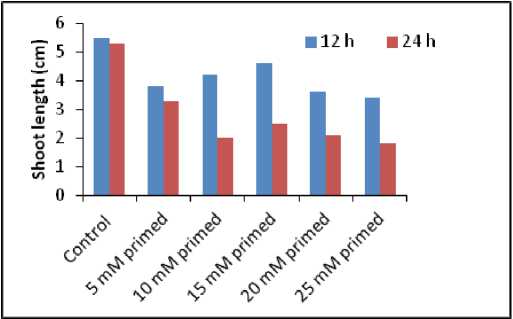
Figure 1. D etermination of priming concentration and priming duration of Sesamum indicum L. var Thilothama

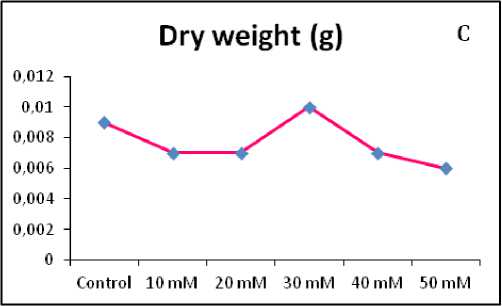
Figure 2. Growth parameters (A-shoot length, B-fresh weight and C-dry weight) of sesame seedlings raised from different concentrations of KNO3 primed seeds
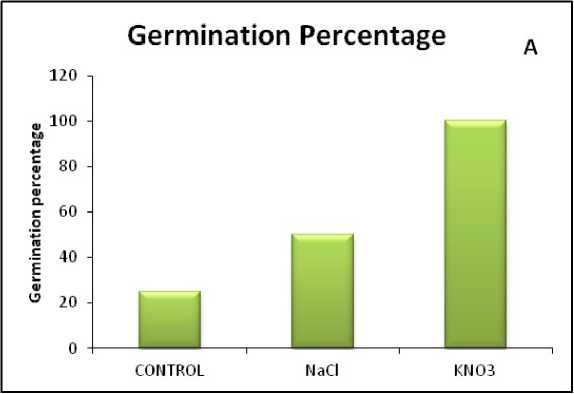
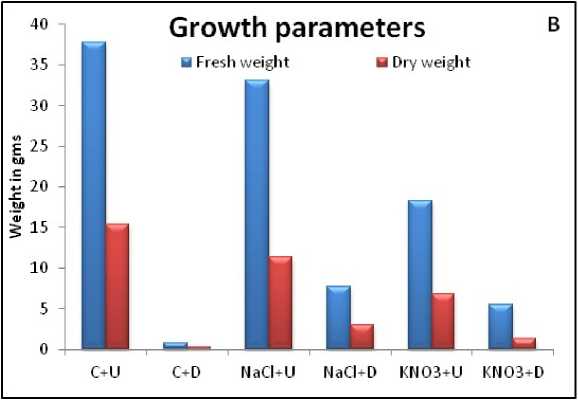
Figure 3. Germination percentage (A) and growth parameters (B) of primed (NaCl and KNO3) and non-primed sesame seeds under field conditions
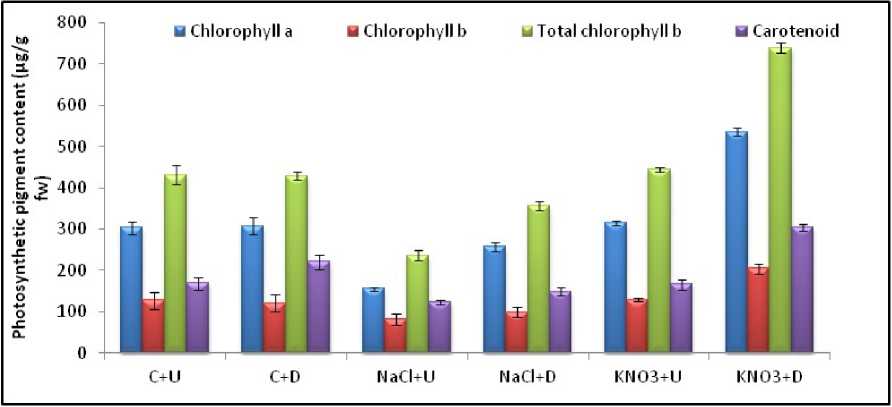
Figure 4. Photosynthetic pigment composition of primed (NaCl and KNO 3 ) and non-primed sesame seeds under stress and unstressed conditions. The vertical bars represent SE of the mean value of recordings.
Table 1: Growth parameters of sesame seedlings raised from primed (NaCl and KNO3) and non-primed seeds under field conditions.
|
SHOOT LENGTH(cm) |
ROOT LENGTH(cm) |
FRESH WEIGHT(g) |
DRY WEIGHT (g) |
|
|
KNO3 PRIMING |
12.75 |
4.3 |
0.781 |
0.03 |
|
NaCl PRIMING |
6.5 |
3.3 |
0.762 |
0.05 |
|
CONTROL |
6.1 |
3.2 |
0.466 |
0.06 |
Table 2: Yield parameters of sesame plants raised from primed (NaCl and KNO3) and non-primed seeds
|
ruit weight(g)/plant |
Seed weight(g)/plant |
|
|
Un-primed |
77.88 |
11.18 |
|
NaCl primed |
88.15 |
15.82 |
|
KNO3 primed |
65.74 |
8.85 |

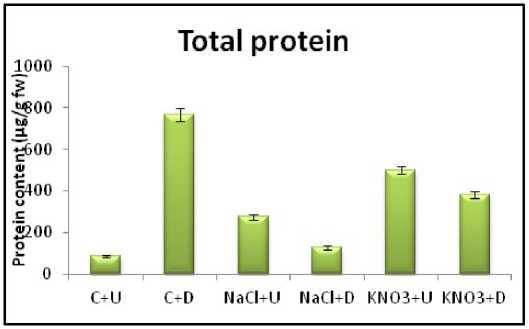
Figure 5. MDA (A), proline (B) and total protein (C) content of primed (NaCl and KNO3) and non-primed sesame seeds under stress and unstressed conditions. The vertical bars represent SE of the mean value of recordings.
CONCLUSION
Abiotic and biotic stresses severely affect the crop’s growth and development at every stage of growth cycle Drought stress is one of the major abiotic stress for crop plants particularly in the tropics. Seed priming is an important method for imparting stress tolerance in various crop plants. In the present study, the halo and osmopriming effects on Sesamum indicum L. var. Thilothama under drought stress were analyzed. The results obtained from the present study suggest that seed priming with NaCl sigmificantly increased the yield parameters while seed priming with KNO3 increased the germination percentage along with synchronised germination. rom the research work, the most appropriate concentration of KNO3 for priming was found to be 30 mM. The seedlings raised from primed seeds imparted good resistance against drought stress also. Among the two seed priming methods, KNO3 priming imparted good seed germination and early seedling growth but the yield was found to be higher in NaCl priming. Thus we suggest both these seed priming methods for increasing drought tolerance in sesame under field conditions. Moreover, in terms of cost effectiveness, we recommend NaCl priming for imparting drought stress tolerance in sesame rather than KNO3 because NaCl is cheaper than KNO3 and is easily available too.
CONFLICTS OF INTEREST
The authors declare that they have no potential conflicts of interest.
Список литературы Seed priming: an efficient method for enhancing growth and yield of Sesamum indicum L. under drought stress
- Arnon DI (1949) Copper enzymes in isolated chloroplasts polyphenoloxidase in Beta vulgaris. Plant Physiol 24:1-5
- Basra SMA, Farooq M, Tabassum R, Ahmad N (2005) Physiological and biochemical aspects of seed vigor enhancement treatments in fine rice (Oryza sativa L.). Seed Sci Technol 33:623-8
- Bates LS, Waldren RP, Teare ID (1973) Rapid determination of free proline for water stress studies. Plant Soil 39: 205-208
- Bradford KJ, Steiner JJ, Trawath SE (1990) Seed priming influence on germination and emergence of pepper seed lots. Crop Sci 30:718-721
- Gao JP, Chao DY, Lin HX (2007) Understanding abiotic stress tolerance mechanisms: recent studies on stress response in rice. J Integr Plant Biol 49:742750
- Heath RL, Packer L (1968) Photoperoxidation in isolated chloroplasts. I- Kinetics and stochiometry of fatty acid peroxidation. Pak J Bot 125:189-198
- Kavi Kishore PB, Sangam S, Amrutha RN, Laxmi PS, Naidu KR, Rao SS, Rao S, Reddy KJ, Theriappan P, Sreenivasulu N (2005) Regulation of proline biosynthesis, degradation, uptake and transport in higher plants: its implications in plant growth and abiotic stress tolerance. Curr Sci 88:424- 438
- Kim, Y. C., Glick, B. R., Bashan, Y. and Ryu, C. M. (2012). Enhancement of plant drought tolerance by microbes. In: Aroca, R. (ed) Plant responses to drought stress: from morphological to molecular features. Springer Verlag, Berlin and Heidelberg, Germany, pp 383-413.
- Lowry, O. H., Rosenbrough, N. J., Farr, A. L. and Randall, R. J. (1951). Protein measurement with Folin-phenol reagent. J. Biol. Chem., 193: 265-275.
- Mittal, R. and Dubey, R. S. (1995). Influence of sodium chloride salinity on polyphenol oxidase, indole 3-acetic acid oxidase and catalase activities in rice seedlings differing in salt tolerance. Trop. Sci., 35: 141-149.
- Mustafa, H. S. B., Mahmood, T., Ullah, A., Sharif, A., Bhatti, A. N., Nadeem, M., & Ali, R. (2017). Role of seed priming to enhance growth and development of crop plants against biotic and Abiotic stresses. Bulletin of Biological and Allied Sciences Research, 2(2), 1-11.
- Nouman, W., Siddiqui, M. T., Basra, S. M. A., Afzal, I. and Rehman, H. U. 2012. Enhancement of emergence potential and stand establishment of Moringa oleifera Lam. by seed priming. Turk. J. Agric. For., 36: 227-235.
- Parera, C.A. and Cantliffe, D. J. (1992). Enhanced emergence and seedling vigor in shrunken-2 sweet corn via seed disinfection and solid matrix priming. J. Amer. Soc. Hort. Sci. 117: 400-403.
- Randhir, R. and Shetty, K. (2005). Developmental stimulation of total phenolics and related antioxidant activity in light-and dark-germinated corn by natural elicitors. Proc. Biochem., 40: 1721-1732.
- Razaji, A., Asli, D. E., & Farzanian, M. (2012). The effects of seed priming with ascorbic acid on drought tolerance and some morphological and physiological characteristics of safflower (Carthamus tinctorius L.). Annals of Biological Research, 3(8), 3984-3989.
- Shabbir, I., Ayub, M., Tahir, M., Bilal, M., Tanveer, A., Hussain, M., & Afzal, M. (2014). Impact of priming techniques on emergence and seedling growth of sesame (Sesamum indicum l.) Genotypes. Scientia, 1(3), 92-96.
- Soren, K.R., Ali,K., Tyagi, A. (2010).Recent advances in molecular breeding of drought tolerance in rice (Oryza sativa L.) Indian Journal of Biotechnology, 9, 233-251.
- Tabrizi, E. F. M., Yarnia, M., Ahmadzadeh, V. and Farjzadeh, N. (2011). Priming effect of different times of maize seeds with nutrient elements in water stress on corn yield. Ann. Biol. Res., 2: 419423.
- Wang, W. X., Vinocur, B., Shoseyov, O. and Altman, A. (2001). Biotechnology of plant osmotic stress tolerance: physiological and molecular considerations. Acta Hort., 560: 285-292.
- Wang, W., Vinocur, B. and Altman, A. (2003). Plant temperatures: Towards genetic engineering for stress tolerance. Planta, 218: 1-14.
- Wang, W., Vinocur, B., Shoseyou, O. and Altman, A. (2004). Role of plant heat shock proteins and molecular chaperones in the abiotic stress responses. Trends Plant Sci., 9: 244-252.
- Zeng, Y. J., Wang, Y. R. and Zhang, J. M. (2010). Is reduced seed germination due to water limitation a special survival strategy used by xerophytes in arid dunes? J. Arid Environ., 74: 508-511.
- Yunpeng, Z., Wang, B., Yan, J., Cheng, L., Yao, L., Xiao, L. and Wu, T. (2014). DL-p-Aminobutyric Acid-Induced Resistance in Soybean against Aphis glycines Matsumura (Hemiptera: Aphididae). PloS one. 9. e85142. 10.1371/journal.pone.0085142

